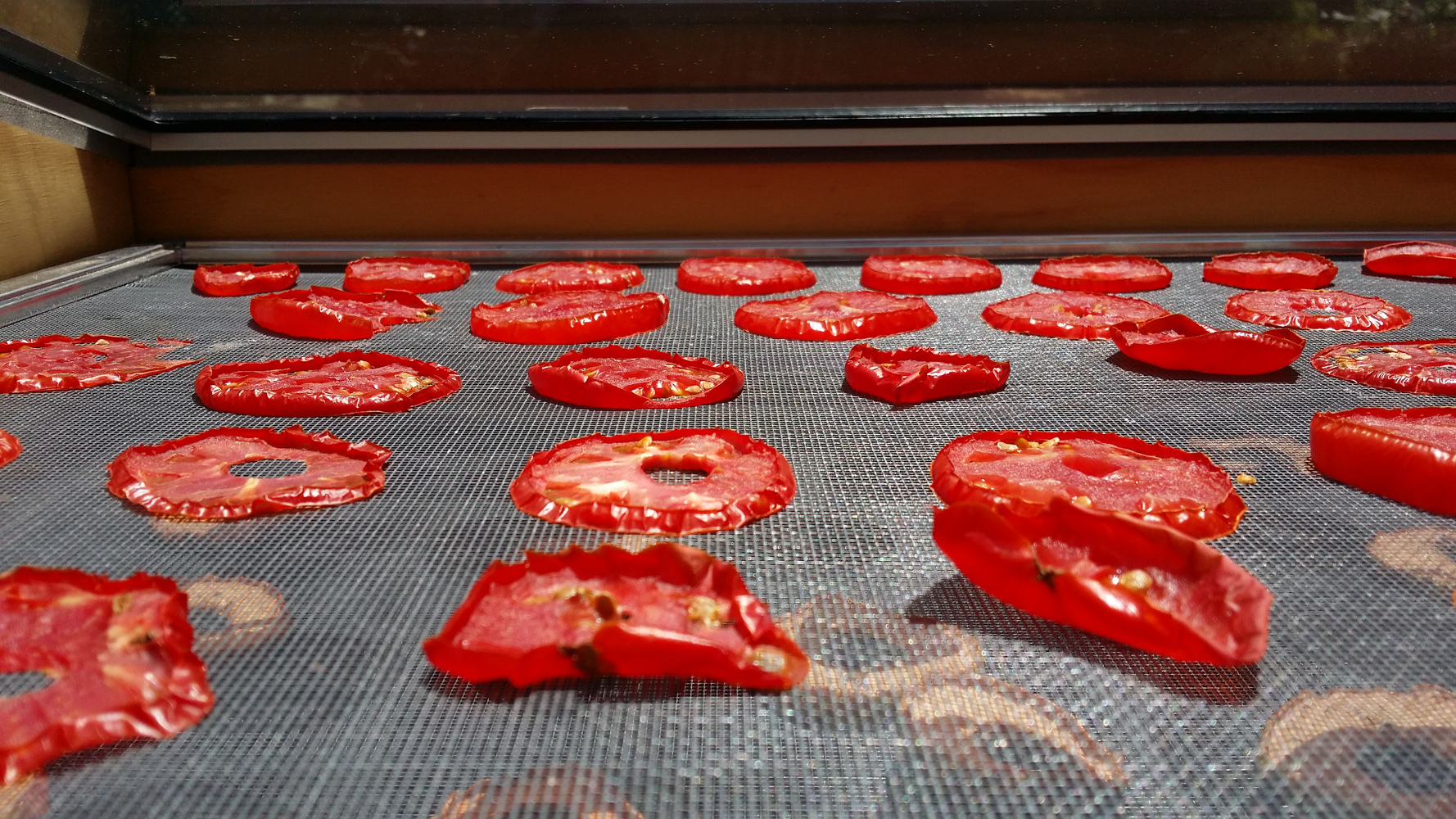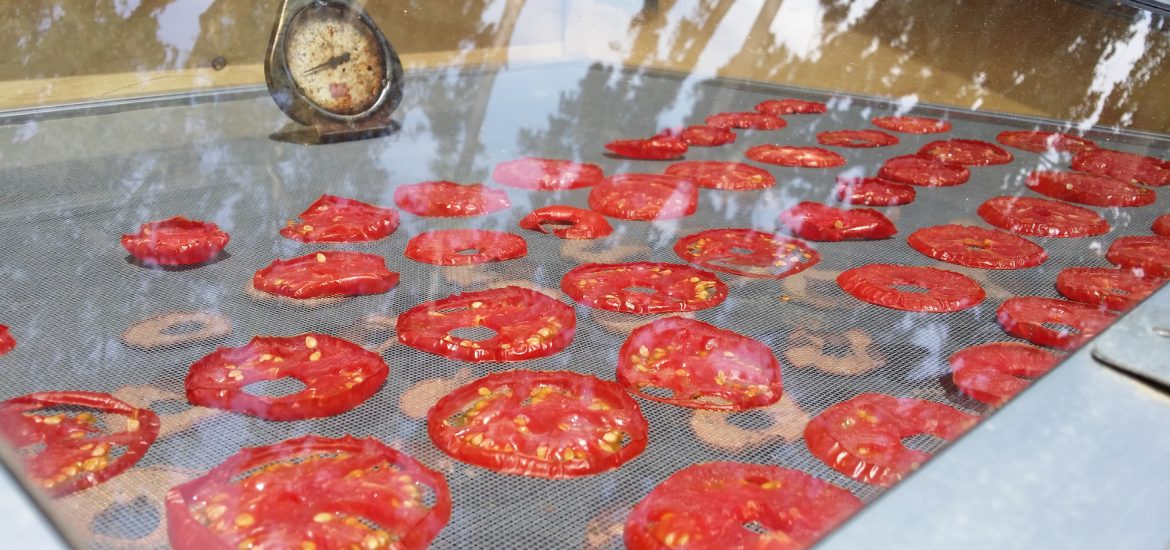I made literal sun-dried tomatoes. And I mean literal in the formerly correct sense of the word…
I used a solar dehydrator for these. I haven’t tried dehydrating tomatoes in my oven. I feel I should use the solar dehydrator since I have access to one but tomatoes should turn out well in the oven. The solar food dehydrator I use can reach temperatures up to 225°F so set your oven temperature approximately there. A couple of bloggers I know have told me that they use the interior of their cars on sunny, hot days to dehydrate food. Just set a cookie sheet spread with food in the windshield and roll up the windows.
If you want to build a solar dehydrator of your own, you’ll find many excellent plans online. The one I use is a wooden box topped with a glass window pane, with a hinged opening on the back, the whole thing raised on four legs. Inside the box sit two horizontal screens, which you pull in and out of the back. Under the lower screen sits a matte black piece of thin metal. A piece of wood covers most of the outside bottom, with a four-inch wide opening across one end, covered with more screening. That gap plus two small vents on the sides help keep the temperature at an ideal range for dehydrating—and not cooking—food.
I don’t have a good pic of the dehydrator with these tomatoes in it but here’s one of kale chips in progress. (And here is the recipe for those.)

Cooking with the sun (or in this case, dehydrating) makes food taste especially delicious. I have made kale chips in the oven using the same ingredients and the solar-made ones taste better, no question. Other good contenders for a solar dehydrator are slices of fruit like apples, nectarines and peaches or fruit leather. Granola would also work well. But back to the tomatoes…

I used beefsteak tomatoes for this post but you could use any type of tomato—heirloom, small Early Girl tomatoes or cherry tomatoes, for example. Leave the cherry tomatoes whole and slice other tomatoes into pieces at least 1/4″ thick. If you’ve never dehydrated fruit or vegetables, you’ll be shocked at how much they shrivel up.


You can see some apple slices on the layer below the tomatoes. Dense fruit dehydrates much slower than tomatoes.

The tomatoes in the above two pics still contain quite a bit of water but they have noticeably shriveled after a couple of hours. As the day progresses, so the dehydrator remains in full sun, I turn it occasionally—every hour or two or simply when I remember to do it.



Tomatoes dehydrate in about half a sunny day in the solar dehydrator I use (depending on the time of day). They require minimal work and zero energy. I simply slice them, spread them on the screens and wait. I added nothing else—no salt, no olive oil. When they’re finished, they taste like candy. They basically are candy. Eat them, store them in a jar for several months (think of how long raisins keep) or store them in a jar of olive oil.



Thank you for this. When I was in the supermarket recently, looking at purchasing dried mango (from the Phillipines – we’re in Australia) at an ridiculous price I realised I could dry them during Summer and enjoy them year round. A win on many fronts. I was interested in the car drying (limited bench space/storage space to accomodate a dehydrator) and had a bit of a poke around online and found this helpful post detailing it: http://www.littleecofootprints.com/2011/02/drying-dehydrating-food-fruit-car.html. I also enjoyed your post on making sesame oil. I will be trying it once we’ve use up our current bottle. It really is almost embarrassing how easy it is to make things most of the time!
Thank you for that link Nikki! The car looks like it works well. I agree, often when I make something new, I can’t believe how easy it is. ~ Anne Marie
Opps, sorry making tahini
I knew what you meant 😉
Could this method work to make potato or apple chips?
Hi Sarah, I have dried apples but they weren’t chips. They were more like chewy candy. Very delicious but not chip-like. I cut them quite thick. I have tried making sweet potato chips but I didn’t cut them thinly enough. They were chewy not crunchy. If you try potatoes (or apples), cut them super thin. I would also toss them in a bit of olive oil. I have successfully made kale chips if you want to check out that post: https://zerowastechef.com/2015/06/28/my-transition-to-full-on-hippie-is-complete-solar-baked-kale-chips/ ~ Anne Marie
I have a solar food dryer I built as well. Wondering how long (or how many days) it took for yours to dry?
Oh cool! It gets up to 225F in there on a hot, sunny day so it doesn’t take long. These dried out in a day. I have put other vegetables in there that took longer, a couple of days. I think I sliced them too thickly. Apples are fast too, just a day. I go outside and move the dryer every couple of hours along the path of the sun as it moves across the sky, or rather as the Earth rotates 😀
How dry do the tomatoes have to be to store in a jar for several months, a year?, and not end up with mold? Yours sound like they still have some moisture in them. Thanks.